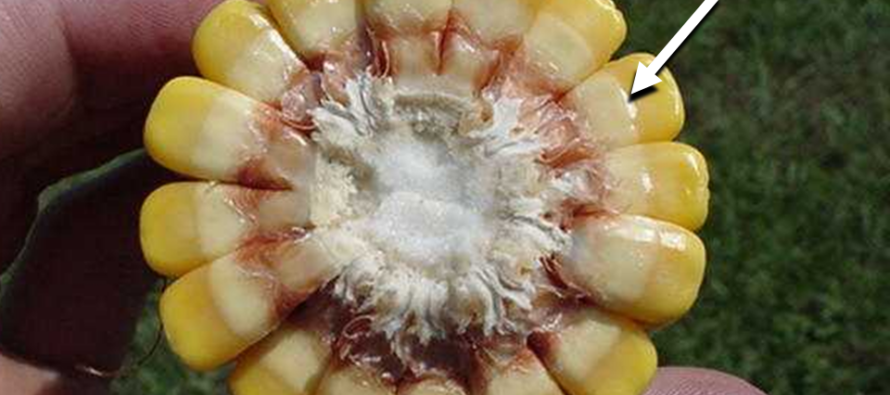When to Terminate Irrigation in Corn

Related Articles
- 2010 Soybean And Corn Variety Trial Data 3
- Spring Nitrogen Fertility Suggestions for Wheat 0
- 2010 Row Crop Short Course Video Links 0
Latest Tweets
Corn maturation will vary depending on planting date and latitude, but our early plantings are now denting and actively filling kernel size and weight. This indicates corn is progressing through its final growth stage, but assuming the crop is already made, particularly when heat or drought stress is prevalent, can quickly erode profitability by limiting kernel development. In fact, nearly 50% of kernel weight is filled after dent. Alternatively, excessive irrigation as the crop reaches maturity wastes time, money and labor from your farm. This information can help you make wise irrigation termination decisions as your corn approaches physiological maturity.
As the corn crop nears maturity, knowing when you can safely terminate irrigation timing, while optimizing kernel development and yield potential is likely the most important management decision you will face. In order to make this decision, you need to be able to estimate when the crop will reach maturity, relative to how much moisture is present in your soil profile. Both crop maturity and soil moisture reserves must be assessed to make a prudent decision. Improper timing will either limit yield potential or unnecessarily waste money and labor. Fortunately, we can outline the steps needed to help make this process accurate and reliable.
Corn kernels continue to gain size and weight until physiological maturity, so you need to make sure to not terminate irrigation or other types of management early when stress will limit grain fill. Thankfully, as kernels progress through the latter stages approaching maturity, there is a method to closely monitor kernel development.
 Kernels mature from the outside-in when hard starch begins forming at the dent stage. The kernel crown will become hard and attain the bright, shiny yellow color of mature kernels. This starch accumulation will steadily progress towards the base of the kernel (where it attaches to the cob) taking about 25 days to complete. This progression of maturity can be monitored by movement of the milk-line or hard starch. The milk-line represents the borderline between where hard starch has occurred and where the kernel has a soft, doughy consistency and is still developing. You can find the milk-line by observing the transition in kernel color from a bright yellow color, to the light, buttery yellow tint on the bottom side of the kernel.
Kernels mature from the outside-in when hard starch begins forming at the dent stage. The kernel crown will become hard and attain the bright, shiny yellow color of mature kernels. This starch accumulation will steadily progress towards the base of the kernel (where it attaches to the cob) taking about 25 days to complete. This progression of maturity can be monitored by movement of the milk-line or hard starch. The milk-line represents the borderline between where hard starch has occurred and where the kernel has a soft, doughy consistency and is still developing. You can find the milk-line by observing the transition in kernel color from a bright yellow color, to the light, buttery yellow tint on the bottom side of the kernel.
To monitor the milk line, break an ear in half and observe the cross-section of the top half of the ear, so you are looking at the side of kernels opposite the embryo. If you have difficulty seeing this color disparity between layers, you can confirm its location by simply poking the seed coat with your fingernail into the soft, doughy layer near the kernel base and repeating progressively toward the crown of the kernel, until you feel the hard starch.
You can use the milk-line development to estimate when the crop will reach physiological maturity. The milk-line progression through the entire kernels lasts about 25 days. Alternatively, each quarter of the kernel fills starch over about 6 days. Therefore, if your milk-line has progressed one-quarter of the way through the kernel, you have about 19 more days to maturity. The formula used to calculate this example is: (25d – (25d x 25% milk line)) = 19 days to maturity.
Once you estimate how long it will take the crop to reach physiological maturity, you must also evaluate your soil moisture reserves to see if you have enough to carry the crop to maturity. You can evaluate moisture using a shovel, probe, auger or other basic methods, but soil moisture sensors serve extremely well for this purpose. We have learned several keys about soil moisture from soil moisture sensors through our efforts in the Corn Verification Program, RISER and PIVOT Programs:
- Mississippi grown corn is fully capable of drawing moisture from at least 36-inches deep during late reproductive stages, if soils or compaction don’t limit water infiltration or root growth.
- The daily soil moisture use rate diminishes considerably as corn approaches maturity, particularly after the dent stage, compared to early reproductive stages. For example, our data show a fully charged soil profile may provide ample moisture for an irrigation cycle up to 15-18 days after dent stage, compared to only 9-12 days during peak water use near tassel.
- Corn’s ability to tolerate stress also increases considerably as it approaches maturity. Therefore, we can use a drier irrigation threshold for termination. In cases where soil moisture is marginal within five days of maturity, we can not generally produce a positive result from supplemental furrow irrigation.





Let me tell You a sad story ! There are no comments yet, but You can be first one to comment this article.
Write a comment